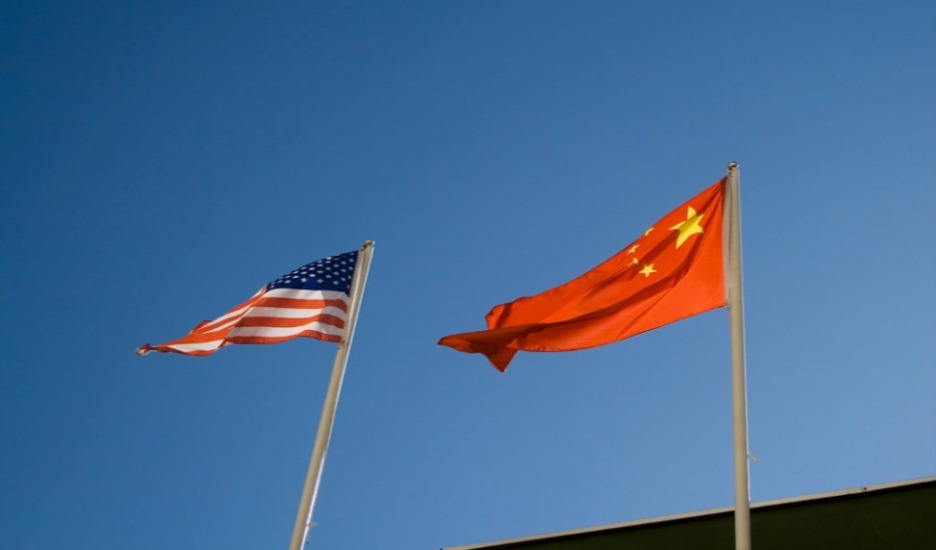China’s Threat of Force in the Taiwan Strait
China is clearly engaged in military intimidation of Taiwan and is not living up to its commitment to settle the cross-strait issues through peaceful means.

Published by The Lawfare Institute
in Cooperation With

On Sept. 18 and 19, People’s Liberation Army combat aircraft on 40 occasions intentionally crossed the median line in the Taiwan Strait that separates mainland China from the island of Taiwan. Taiwan President Tsai Ing-wen immediately condemned the provocation as a “threat of force.”
The center line in the Taiwan Strait (also known as the median line, middle line or Davis Line, named after Brig. Gen. Benjamin Davis, commander of Task Force 13 in Taipei and famed commander of the World War II Tuskegee Airmen) has its origins in the 1954 U.S.-Taiwan Mutual Defense Treaty. The treaty was one link in the chain of U.S. collective defense arrangements in the Western Pacific—which included agreements with the Republic of the Philippines, Australia, New Zealand, Japan and the Republic of Korea—designed to resist further communist subversive activities directed against their territorial integrity and political stability. Pursuant to Article V of the Mutual Defense Treaty, an armed attack in the treaty area, which included Taiwan and the Pescadores (or Penghu) Islands, directed against the territory of either party would be considered a danger “to its own peace and safety” and each party “would act to meet the common danger in accordance with its constitutional processes.” An addendum to the treaty established a buffer zone into which U.S. aircraft were not allowed to enter.
The airspace that encompasses the center line in the Taiwan Strait is international airspace, and so all nations, including China, may exercise high seas freedom of overflight in this area. China is therefore not legally prohibited from crossing the line. However, even though China does not officially recognize the existence of the de facto center line, there has been a tacit understanding on both sides of the strait to respect the unofficial boundary. Since the line was established in 1954, there have been only four reported Chinese military incursions across the line. The first intrusion occurred in July 1999, in response to then-Taiwan President Lee Teng-hui’s declaration that a state-to-state relationship existed between Taiwan and China. In July 2011, two Sukhoi Su-27 fighters briefly crossed the center line when they attempted to intercept a U.S. U-2 reconnaissance plane over the Taiwan Strait. A third incursion occurred in April 2019, when two Chinese Shenyang J-11 fighters crossed the buffer and came within 115 miles of Taiwan before being intercepted by Taiwanese fighters. Then in August 2020, two Chinese air force fighters crossed the center line to protest U.S. Health Secretary Alex Azar’s visit to Taipei, the highest-level U.S. official visit to Taiwan since 1979.
China’s most recent incursions go beyond their previous flyovers in both scope and size, raising the possibility that these actions constitute an impermissible threat to use force against Taiwan. The U.N. Charter requires member states to “refrain in their international relations from the threat or use of force against the territorial integrity or political independence of any state, or in any other manner inconsistent with the Purposes of the United Nations.” In this instance, China’s show of force was unprecedented—40 incursions across the center line by 19 combat aircraft (two Xian H-6 bombers, four Chengdu J-10 fighters, four Shenyang J-11 fighters, eight Shenyang J-16 fighters, and a Shaanxi Y-8 anti-submarine warfare plane). The sheer number of combat aircraft crossing this line raises the question of whether China’s actions were a legitimate exercise of their right of overflight in international airspace or whether these incursions could be viewed as a threat of the use of force in violation of the U.N. Charter. While previous center-line violations have been minor in nature and have been conducted with minimal forces—two fighter jets on each occasion—Beijing’s latest actions are no longer just a symbolic expression of displeasure with U.S.-Taiwan relations. The overflights were apparently designed to punish Taipei for hosting U.S. Under Secretary of State Keith Krach’s official visit to Taiwan. But the nature and scope of the repeated incursions cross the line of a lawful countermeasure, and violate China’s obligations under the U.N. Charter to refrain from the threat or use of force in its international relations. The aggressive and unprecedented intervention by advanced combat aircraft unnecessarily raised the risk of miscalculation and military confrontation and was clearly designed as an act of coercion to alter the status quo in cross-strait relations.
Beijing believes its military operations are consistent with international law, claiming that it does not recognize the center line and that Taiwan is part of mainland China. Nonetheless, Taiwan has indicated that, although it will not provoke China, it will respond in self-defense if attacked by the People’s Republic. Although the U.S.-Taiwan Mutual Defense Treaty is no longer in effect, an armed attack by China would still have implications for the United States. The 1979 Taiwan Relations Act clearly provides that “any effort to determine the future of Taiwan by other than peaceful means” would be viewed as “a threat to the peace and security of the Western Pacific area and of grave concern to the United States.” Moreover, even though the United States recognizes the People’s Republic of China as the sole legal government of China, the United States maintains cultural, commercial and other unofficial relations with the people of Taiwan.
The Taiwan Relations Act, enacted on April 10, 1979, codifies the basis for continued commercial, cultural and other relations between the United States and Taiwan. The act is designed to help maintain peace, security and stability in the Western Pacific, which are in the United States’s political, security and economic interests and are matters of international concern. The act also specifies that the U.S. decision to establish diplomatic relations with the People’s Republic of China was made with “the expectation that the future of Taiwan will be determined by peaceful means” and that any effort to determine the future of Taiwan by other than peaceful means would be viewed with grave concern by the United States. Beijing’s current behavior toward Taiwan is inconsistent with China’s commitment to determine the future of Taiwan by peaceful means.
The Taiwan Relations Act allows the United States to provide Taiwan with necessary defense articles and services to enable Taipei to maintain a sufficient self-defense capability. Moreover, the president is required to inform Congress promptly of any threat to the security or the social or economic system of Taiwan and any danger this poses to U.S. interests.
In a 1982 Joint Communiqué, the United States reaffirmed the principles in the 1972 and 1979 Joint Communiqués regarding the “One-China Policy.” These assurances were given, however, with the understanding and appreciation of China’s Message to Compatriots in Taiwan (Jan. 1, 1979) and China’s Nine-Point Proposal (Sept. 30, 1981) outlining China’s fundamental policy of striving for a peaceful resolution of the Taiwan question. Moreover, during the negotiations of the 1982 Communiqué, President Reagan agreed to a set of guidelines—the Six Assurances—to use in conducting U.S.-Taiwan relations, and directed that the guidelines be communicated to Taiwan and to the U.S. Congress. Today, the Taiwan Relations Act and the Six Assurances are the cornerstones of U.S. relations with Taiwan and reflect the U.S. interest in preserving cross-strait peace and stability.
Section 1260c of the fiscal 2020 National Defense Authorization Act calls on the Defense and State departments to review the Taiwan Relations Act to determine, among other things,
whether the PRC or Chinese Communist Party are affecting through military, economic, information, digital, diplomatic, or any other form of coercion—(A) the security, or the social and economic system, of Taiwan; (B) the military balance of power between the PRC and Taiwan; or (C) the expectation that the future of Taiwan will continue to be determined by peaceful means.
Based on this review, the secretary of defense, in coordination with the secretary of state, shall provide Congress with a report to include recommendations on legislative and policy changes to ensure the United States continues to meet its obligations under the act, as well as “the regular transfer of defense articles, especially defense articles that are mobile, survivable, and cost effective, to most effectively deter attacks and support the asymmetric defense strategy of Taiwan.”
Given recent scenario-based combat exercises in the Taiwan Strait and multiple incursions across the center line, China is clearly engaged in military intimidation of Taiwan and is not living up to its commitment to settle the cross-strait issues through peaceful means. China’s malfeasance reaffirms the need for continued U.S. support and engagement with Taiwan. It should therefore come as no surprise to China that the United States recently agreed to a $62 billion, 10-year deal to sell F-16 fighters to Taiwan. Until it lives up to its commitments under the various Joint Communiqués, Beijing should expect U.S.-Taiwan bilateral ties to increase and strengthen, including high-level diplomatic exchanges and increased defensive weapons sales.


.jpg?sfvrsn=5a43131e_9)


